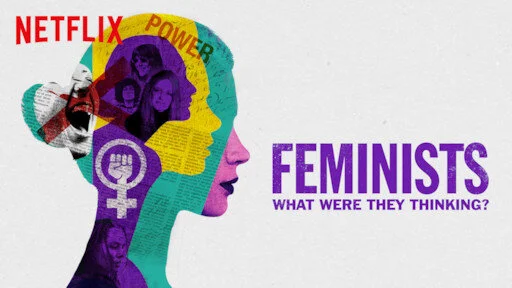Movie Review: Feminists: What Were They Thinking?
Feminists: What Were They Thinking? opens with a flip through an old photo album, showcasing page after page of black-and-white photographs of women. Powerful feminists of all ages, including celebrities like Lily Tomlin, Judy Chicago, Jane Fonda, author and professor Phyllis Chesler, and so many others. In the recent Netflix documentary, these women share what it’s been like fighting for equality in the 1940s, the 1960s, and still today.
A Picture Is Worth A Thousand Words
Photographer Cynthia MacAdams believes feminism makes women look different, and she wanted to see if that difference showed up in photographs. She started snapping photos of newly liberated women at the onset of Second Wave Feminism.
She started with women artists, writers, and activists she already knew. Gradually, she made her way to the streets of New York to find more women for her collection.
Cynthia MacAdams captured the newfound freedom Second Wave Feminism brought women in the United States. In Feminists: What Were They Thinking?, Netflix interviews some of the women photographed in her series to discover what they think of when they look at their photograph, and to find out how feminism has impacted their lives since it was taken.
The Embryonic Kicking of Feminism
Actress Lily Tomlin recounts once watching a husband and wife interact after a showing of the 1958 film, Gentlemen Prefer Blondes. She remembers the wife arguing, “those women don’t have any talent,” and the husband responding, “they don’t need any.”
“That was epiphanous for me,” says Tomlin. Her partner, Jane Wagner, responded, “I felt the embryonic kicking of feminism, even though I didn’t know I was pregnant.”
Other prominent figures, like violinist Marcy Vaj, share similar stories from adolescence. “I was in high school and I was getting poor grades,” Vaj says. “I remember my father saying, ‘Oh, it doesn’t matter, she’ll get married anyway.’ That still rings in my ears.
Feminists: What Were They Thinking? is full of stories like these. Moments when women of all ages and walks of life first realized what it meant to be born a woman — and the moments when they started to get angry, wondering what they could do to change the way things are.
Not Just A Women’s Issue
Thread between the scenes of well-known women sharing their experiences growing up under the male gaze are video clips and old, photo-copied images from prominent social and political movements throughout history. From the Stonewall Riots to the 1975 World Conference on Women to the more recent Women's March, Feminists: What Were They Thinking? showcases historical moments that changed women’s lives forever.
“We wanted to win our autonomy,” says Catharine Stimpson, recounting her experiences marching for equality in the 1970s. “We wanted to win the rights to our bodies. We wanted to have our voices heard. We wanted to get our poems on the page. We wanted to win.”
Although some people still mistakenly assume that in order for these milestones to be met, men’s voices must be stifled, the documentary reminds us that the opposite is true. “Saying this is just a ‘women’s issue’ or an ‘environmental issue’ creates division,” says Celine Kuklowsky. “We can’t do that anymore. That’s what patriarchy does.”
Artist Meredith Monk echoes Kuklowsky’s sentiments, reminding us that we’re not in this fight just for ourselves. “In a sense, I consider myself a humanist,” Monk says. “I think if there’s an advance in half of the human race, then that also helps the other half of the human race.”
Women of Color
Feminists: What Were They Thinking? only scratches the surface of intersectional feminism. Many women of color interviewed in the documentary expressed their frustration with balancing multiple identities. “Black women are asked to separate their gendered identities. But we can’t divide the troops,” says playwright, professor, and artist Funmilola Fagbamila.
“As a black woman, it’s often hard to identify as a feminist, because it’s just so stigmatized in our communities. As soon as you announce that you’re a feminist, it’s assumed that you’re against the black man, and it’s just not true,” Fagbamila says. “So where do black women exist in this conversation? In black spaces, you can’t talk about your gender, and in women’s spaces you can’t talk about your race. But you are both — equally.”
Deficit and Disobedience
Let’s face it, feminism is an everybody issue — and there is still so much work to be done. Women of my generation have the women in this documentary, and so many others, to thank for paving the way toward a more equal and equitable future for all. As women, our voices and opinions are often shut down, if for no other reason than because of our identity.
From an early age, we are taught to be obedient—even when we want to be disruptive. “At 13, I had to make a choice — whether I would believe what the world said, or whether I would believe my own experience,” says Judy Chicago. “As a young woman, I awoke to the deficit of information on women’s history, women’s art, and women’s experiences in the cultural dialogue. I wanted to change that. But in order to change it, I had to become disobedient.”
If Feminists: What Were They Thinking? teaches us one thing, it’s that radical change is never linear. The documentary proves that progress is slow. That progress in feminism, like every movement, often looks like three steps forward and two steps back. Nevertheless, we persist. As Phyllis Chesler asserts, “that feminism has a future is inevitable.”




